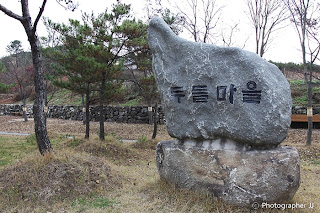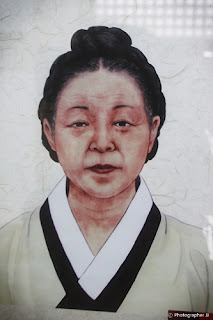This weekend, I decide to visit at Youngju city.
Because of the fresh and breezy weather, I like the season, autumn.
The blue sky makes me to go anywhere today.
The street is over shadowed by big and tall tree.
Look at this tree’s big compare to the car~
I would ride a bicycle if I have one on the road.
The clean and calm road was beautiful.

There were ginkgo trees on either side of the road.
The yellow color was so ~~~ yellowing~ It was so pretty.
Maybe because yellow is my favorite color…?
This house called Bongdo-gack, which was rest place for people in old age.
Next, I visited in Buseoksa temple.
There was a great pond the entrance of Buseoksa.
Here, parking fee is 3,000won for a day.
The entrance fee is 1,200won for adult, 1,000won for teenager, 800won for kids...
I marveled at the beautiful fall foliage of the road.
I picked up some of these to make bookmark.
I used to make book maker and give it to my friends.
It remind me my young age~

A lot of visitor enjoyed the beautiful fall season to spend time with maple trees.
Buseoksa, the "Temple of the Floating Stone", was founded by the great monk Uisang in 676 AD, the 16th year of King Munmu of Silla.
The temple was built following Uisang's return from China, where he had heard reports that the Chinese emperor was planning to invade Korea (these reports turned out to be true). Uisang convinced the king of Silla that constructing Buseoksa would invoke Buddha's help in warding off this threat.
Apparently it worked, for the Koreans fended off the Chinese armies and secured the unification of Korea.
The meaning of the Buseok-sa is that there are two apart rocks, one on the top and another one is on the bottom.
Mayple trees are everywhere~

People were so busy to take a picture.

I looked down the Buseoksa's view from the top of the hill.
It was very nice of view.
Originally this road is famous for ginkgo leaves but I could see it at all due to it’s all gone.
I was little upset.Lunch time!!
I choose the restaurant one of the nicest one I guess.
There were Korean traditional dishes and soup.
I wanted to eat them all but I couldn’t….
It was very tasty.
A baked mackerel was so goooooooood!
After eating a lunch, I went to Sosu Seowon and sunbi town.
Sosu-Seowon and Sunbi town were in same place.
I didn’t have to pat separately.
The fee was only 3,000won.
There was some standing poetry on the way to get in there.
Sosu Seowon is the oldest seowon, private Neo-Confucian academy in Korea which was established during the Silla Kingdom period.
It was found at the entrance of Suksusa Temple, in Yeongju City, Gyeongsangbuk-do South Korea.
Sosu Seowon was founded by Ju Sebung ( 1495-1554), who was serving as magistrate of Pungseong county.
Sosu Seowon was the only seowon that survived from the Seowon Abolishment by Heungseon Daewongun Regent in 1871.
It has been well preserved retaining most of its old structures and is designated as National Treasure of South Korea No.55

Next I moved to Sunbi town.

The village has preserved the housing architecture and village structure of Chosan Dynasty. We stayed one night in the village’s cottage.
Even though there were not many people, it was pretty fun~
It was perfect place for stroll in the woods due to the air was so fresh and clean.
Sobaeksan was designated as the 18th national park in Korea on December 14,1987.
It has a total area of 322.383㎢ and is the third largest mountainous national park in Korea following jirisan and Seoraksan.
Sobaeksan has many divine peaks beginning with Birobong which stands at 1,439.5m to Gungmangbong(1,420.8m), Yeonhwabong(1,383m), and Dosolbong(1,314.2m).
The park area stretches across the boundaries of Gyeongsangbuk-do Yeongju, Chungcheongbuk-do danyang, and Gangwon-do Yeongwol.
The huibang and Jukgye valleys in Yeongju flow into Nakdonggang(River) and the other valleys such as Cheondong, Edui, Jungyeong and Namcheon in Danyang flow into Namhangang(River).
I felt refreshment of mind and body after waking the valley.
I just walked along the water saying nothing. I felt so good.
The walkway was made for walking easily.
It was getting a dark, so I didn’t go on the top.

It was a little late to enjoy the fall season but the weather was so good and I had really wonderful time in Youngju trip.
It was a shame that I could not see the gingko tress’s street and hiking on the top of the Sobaek Mountain.
I hope I can come here next year then enjoy full of autumn in Korea.
Because of the fresh and breezy weather, I like the season, autumn.
The blue sky makes me to go anywhere today.
The street is over shadowed by big and tall tree.
Look at this tree’s big compare to the car~
I would ride a bicycle if I have one on the road.
The clean and calm road was beautiful.

There were ginkgo trees on either side of the road.
The yellow color was so ~~~ yellowing~ It was so pretty.
Maybe because yellow is my favorite color…?
This house called Bongdo-gack, which was rest place for people in old age.
Next, I visited in Buseoksa temple.
There was a great pond the entrance of Buseoksa.
Here, parking fee is 3,000won for a day.
The entrance fee is 1,200won for adult, 1,000won for teenager, 800won for kids...
I marveled at the beautiful fall foliage of the road.
I picked up some of these to make bookmark.
I used to make book maker and give it to my friends.
It remind me my young age~

A lot of visitor enjoyed the beautiful fall season to spend time with maple trees.
Buseoksa, the "Temple of the Floating Stone", was founded by the great monk Uisang in 676 AD, the 16th year of King Munmu of Silla.
The temple was built following Uisang's return from China, where he had heard reports that the Chinese emperor was planning to invade Korea (these reports turned out to be true). Uisang convinced the king of Silla that constructing Buseoksa would invoke Buddha's help in warding off this threat.
Apparently it worked, for the Koreans fended off the Chinese armies and secured the unification of Korea.
The meaning of the Buseok-sa is that there are two apart rocks, one on the top and another one is on the bottom.
Mayple trees are everywhere~

People were so busy to take a picture.

I looked down the Buseoksa's view from the top of the hill.
It was very nice of view.

Originally this road is famous for ginkgo leaves but I could see it at all due to it’s all gone.
I was little upset.
I choose the restaurant one of the nicest one I guess.
There were Korean traditional dishes and soup.
I wanted to eat them all but I couldn’t….
It was very tasty.
A baked mackerel was so goooooooood!
After eating a lunch, I went to Sosu Seowon and sunbi town.
Sosu-Seowon and Sunbi town were in same place.
I didn’t have to pat separately.
The fee was only 3,000won.
There was some standing poetry on the way to get in there.
Sosu Seowon is the oldest seowon, private Neo-Confucian academy in Korea which was established during the Silla Kingdom period.
It was found at the entrance of Suksusa Temple, in Yeongju City, Gyeongsangbuk-do South Korea.
Sosu Seowon was founded by Ju Sebung ( 1495-1554), who was serving as magistrate of Pungseong county.
Sosu Seowon was the only seowon that survived from the Seowon Abolishment by Heungseon Daewongun Regent in 1871.
It has been well preserved retaining most of its old structures and is designated as National Treasure of South Korea No.55

Next I moved to Sunbi town.

The village has preserved the housing architecture and village structure of Chosan Dynasty. We stayed one night in the village’s cottage.
Even though there were not many people, it was pretty fun~
It was perfect place for stroll in the woods due to the air was so fresh and clean.
Sobaeksan was designated as the 18th national park in Korea on December 14,1987.
It has a total area of 322.383㎢ and is the third largest mountainous national park in Korea following jirisan and Seoraksan.
Sobaeksan has many divine peaks beginning with Birobong which stands at 1,439.5m to Gungmangbong(1,420.8m), Yeonhwabong(1,383m), and Dosolbong(1,314.2m).
The park area stretches across the boundaries of Gyeongsangbuk-do Yeongju, Chungcheongbuk-do danyang, and Gangwon-do Yeongwol.
The huibang and Jukgye valleys in Yeongju flow into Nakdonggang(River) and the other valleys such as Cheondong, Edui, Jungyeong and Namcheon in Danyang flow into Namhangang(River).
I felt refreshment of mind and body after waking the valley.
I just walked along the water saying nothing. I felt so good.
The walkway was made for walking easily.
It was getting a dark, so I didn’t go on the top.

It was a little late to enjoy the fall season but the weather was so good and I had really wonderful time in Youngju trip.
It was a shame that I could not see the gingko tress’s street and hiking on the top of the Sobaek Mountain.
I hope I can come here next year then enjoy full of autumn in Korea.




























































